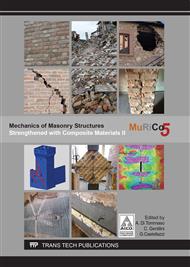p.628
p.638
p.646
p.653
p.662
p.670
p.678
p.686
p.694
In-Plane Behavior of Plain and Strengthened Solid Brick Masonry Walls
Abstract:
Unreinforced masonry structures are generally vulnerable to earthquake actions. Brittle masonry walls are very stiff and attract considerable seismic forces which cannot be sustained without cracking. In order to enhance ductility and load bearing capacity, certain strengthening techniques need to be applied. An experimental program concerning in-plane behavior of solid clay brick masonry walls was performed at the Institute for Materials and Structures, Faculty of Civil Engineering University of Sarajevo, in cooperation with Institute for Lightweight Structures and Conceptual Design, University of Stuttgart. The physical models include two unconfined unreinforced full scale masonry walls L/H/D=233/237/25cm and two strengthened full scale walls jacketed on both sides with 5cm thick concrete and reinforced with Q196 steel mesh. Twelve reduced scale walls L/H/D = 100/100/25cm were additionally constructed in order to test different strengthening methods which include one-or two-sided jacketing and CFK 150 strips. Specimens were exposed to cyclic shear as well as to monotonic push over loading program for different vertical stress levels with the aim to quantify shear strength, stiffness and energy dissipation. For lower vertical loads the tested walls exhibit rigid body rotation in each displacement cycle. For higher precompression mixed flexural and shear failure mode was registered, characterized by toe crushing and diagonal cracking. No separation of jacketing from the masonry was detected. Numerical models of tested wall panels were developed using finite element programs.
Info:
Periodical:
Pages:
694-701
Citation:
Online since:
July 2017
Authors:
Price:
Сopyright:
© 2017 Trans Tech Publications Ltd. All Rights Reserved
Share:
Citation:


